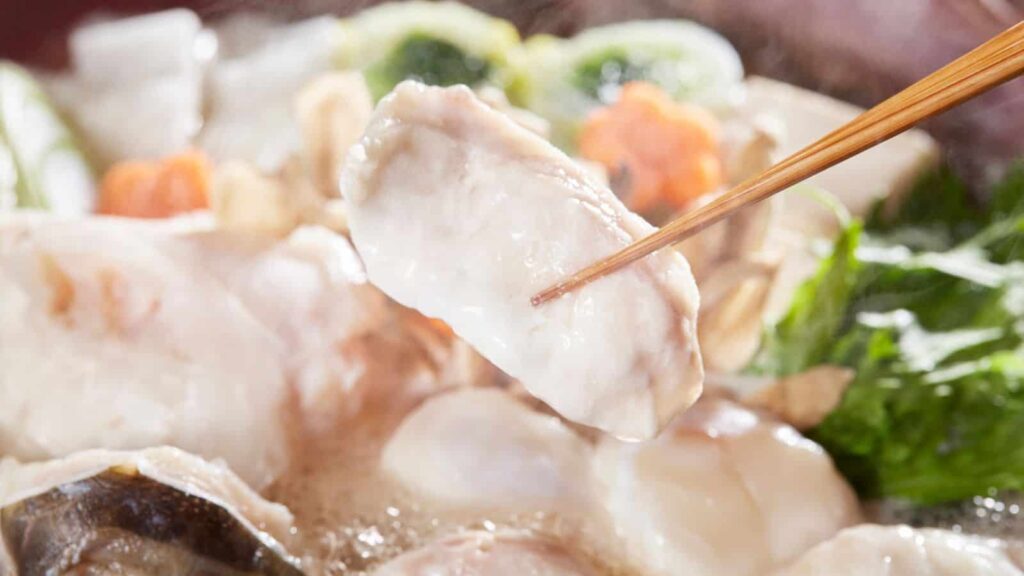Exploring exotic and unusual foods is exciting, but it also comes with its risks. These 17 foods are among the most dangerous across the globe, notorious for their potential health hazards. They often need to be prepared in a precise way to ensure they’re safe to eat.
Fugu (Pufferfish)

A Japanese delicacy made from pufferfish, fugu is strictly regulated across the country. According to Food & Wine, “Its poison is so potent that chefs have to take a national written and practical examination just to be able to cook it.” Despite this, there are often several cases of poisoning each year.
Ackee Fruit

Native to West Africa, ackee is the national fruit of Jamaica, and you’ll often find it used in Caribbean cuisine. While it’s perfectly safe to eat once ripened, the unripe fruit contains hypoglycin A, which is a toxin that can cause Jamaican vomiting sickness. This illness can be fatal if it is left untreated.
Rhubarb Leaves

The pink stalks of rhubarb make a great filling in pies or desserts, but the leaves are poisonous and should never be consumed. The leaves contain a toxin called oxalic acid, which, when consumed, can cause kidney stones, seizures, and even acute kidney failure.
Cassava

Cassava is a popular source of carbohydrates throughout Africa, Asia, and Latin America; however, it needs to be prepared properly. Medical News Today says, “People should not eat cassava raw, because it contains naturally occurring forms of cyanide, which are toxic to ingest.”
San-nakji (Live Octopus)

San-nakji is a Korean specialty dish that features a small, live octopus cut into pieces and served immediately. Often, it will still be moving. While the octopus is safe to eat, the act of eating it in this manner means there is a risk of choking as the suction cups can stick to the mouth or throat as you swallow.
Elderberries

According to Healthline, “Symptoms of eating uncooked berries, leaves, bark, or roots of the elderberry include nausea, vomiting, and diarrhea.” These symptoms are a result of the cyanogenic glycosides, which can produce cyanide when metabolized. The berries are safe to eat once cooked and are commonly used in jams, syrups, and drinks.
Blood Clams

Harvested in the Gulf of Mexico, the Atlantic Ocean, and the Pacific Ocean, blood clams are known for their red hemoglobin-containing fluids. Because these clams live in low-oxygen environments, they can harbor viruses and bacteria such as hepatitis A, typhoid, and dysentery. As a result, you should ensure the clams are thoroughly cooked before eating.
Pangium Edule (Football Fruit)

Often served in Indonesian cuisine, this fruit is used as a spice across Southeast Asia, but only once properly prepared. To ensure it’s safe, the seeds should be boiled and fermented to reduce the content of cyanide before they’re consumed.
Raw Cashews

The shells of raw cashews contain urushiol, a chemical that is also found in poison ivy and can cause skin rashes and other allergic reactions. MedicineNet says, “Removing the shells from raw cashews and roasting them destroys urushiol.” While you may see ‘raw’ cashews in the store, they’re actually steamed.
African Bullfrog

In Namibia, the African bullfrog is a delicacy that is sometimes eaten as a protein source or at celebratory events. It’s essential to only consume older, mature bullfrogs, as the younger animals may harbor toxins that lead to kidney failure. They can also only be eaten after specific rainy seasons, when the levels of toxins reduce.
Hákarl (Fermented Shark)

A traditional Icelandic delicacy, hákarl is made from the Greenland shark, which is naturally toxic due to its high levels of urea and trimethylamine oxide. Only once it has been fermented for several months will these toxins be reduced to a safe level.
Hot Peppers (Capsaicin Content)

Chili peppers are ranked on the Scoville scale, which measures their spice level. Some of the world’s hottest peppers, such as the Carolina Reaper and ghost pepper, can cause severe distress to your stomach, including intense pain. These peppers are used across the globe, but only in small quantities within a dish.
Nutmeg

Widely used in cooking and baking, nutmeg is known for the warm, nutty flavor it adds to dishes. Typically, the spice is safe to use as it’s added in such small quantities, but if you were to consume a large amount, you may develop symptoms such as hallucinations, dizziness, and nausea.
Star Fruit (Carambola)

This fruit is popular in many parts of Asia and is known for its distinctive star shape when sliced. Healthy individuals are able to eat starfruit with no adverse effects, but it can be fatal for people with kidney problems, who may suffer from confusion, seizures, or other neurotoxic effects after eating it.
Apricot Kernels

The kernels in apricots are often eaten due to their supposed cancer-fighting properties, but they can cause serious health issues if too many are eaten. This is because the pits contain a chemical called amygdalin, which can be converted to cyanide in the body.
Green Potatoes

Potatoes can turn green when they are exposed to light, which produces a natural chemical called solanine. When eaten in large amounts, this can cause nausea, headaches, and neurological problems. To avoid this, it’s best to store your potatoes in a cool, dark place.
Raw Milk

Raw milk is milk that hasn’t been pasteurized. Pasteurization is normally carried out to kill harmful bacteria such as E. coli, Salmonella, and Listeria, all of which can cause serious illnesses. As a result, it’s recommended to avoid raw milk, although many people argue it has good nutritional benefits.
Up Next: 20 Seriously Stunning Natural Wonders Across America

Geological wonders, diverse ecosystems, and impressive waterfalls—the U.S. is home to a huge range of breathtaking landscapes and natural wonders across its many national parks and attractions. Head to these 20 locations for true natural beauty and never-ending adventure opportunities.
20 Seriously Stunning Natural Wonders Across America
17 Places That Undercover Cops Will Always Monitor

While it isn’t always obvious, undercover cops play a crucial role in maintaining public safety. They blend into the background in various locations, carefully observing and acting to prevent crime. In this article, we’ll reveal 17 places where you’re likely to find undercover cops—though you can bet you won’t see them!
17 Places That Undercover Cops Will Always Monitor
17 Things You’re Just Too Old To Be Doing Anymore

The older you get, the more fragile you are physically and mentally, so it’s important to prioritize your well-being every day. Whether you still feel young at 50 or are closer to 80, we’ve compiled 17 things you’re too old to be doing anymore.

